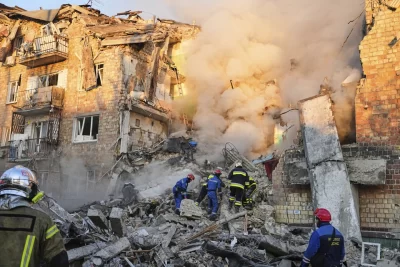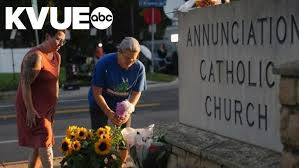
KFAR AZA, Israel — On a sun-dappled day in Kibbutz Kfar Aza, Liora Eilon stood at the spot where her son was killed. She stooped to pick a figurine from the pile of belongings scattered around an abandoned home nearby.
“Every time we come here, Tal leaves us a little message,” the 71-year-old said, turning over the plastic soldier in her hands.
It has been a year since Hamas militants stormed into this community within sight of the border fence surrounding Gaza. Eilon’s 46-year-old son, Tal, who was the Kfar Aza civilian defense commander, was killed in the early moments of the attack, as he ran to the kibbutz armory to grab a weapon.
Now living in a university dormitory in Israel’s north, Liora Eilon wonders if she’ll ever return home to this place, seared into Israeli history for that day of mass death, when the militants killed some 1,200 people in southern communities and took about 250 others hostage. The attack sparked an ongoing Israeli campaign in Gaza that has killed more than 41,600 Palestinians and laid waste to much of the territory.
“How can I trust the government who abandoned me here, who betrayed me, promised me that my family was safe here?” she said. “The government wants us to go back to Kfar Aza, but I need more to feel safe.”
Only about 50 of Kfar Aza’s 1,000 residents have returned. They live among the skeletons of houses burned by explosives, riddled with bullet holes or reduced to rubble by tank shells during the battle that raged for days.
The others are scattered in dorms and hotels further north. The Associated Press spoke to a dozen residents who shared feelings of extreme vulnerability to future attack and deep misgivings about Israel’s military and government, and the Palestinians on the other side of the fence.
Some wondered whether such a scarred place could ever be lived in at all.
“Are we going to live inside a memorial? Are we going to see a plaque every few meters, he was killed here and he was killed here?” asked Zohar Shpack, 58, who has returned and serves in the civilian defense squad. “I don’t know yet.”
‘It’s still the seventh of October’
The seasons have spun by since Oct. 7. Relatively untended, Kfar Aza’s orchards have borne new fruit. With few to harvest, soldiers guarding the community have their pick from loads of fresh avocadoes.
The land still holds traces of the day. On trees hung with fresh pomegranates, some of last year’s fruit remains, charred and black like used grenades. Gardener Rafael Friedman says he still finds teeth and bones in the soil when he rakes back the overgrowth — likely remnants of Hamas militants killed in the fighting.
Kfar Aza has always been a close-knit place. It takes just 15 minutes to walk from one end to the other, past neighborhoods, orchards and a soccer pitch. Many residents grew up here and raised families alongside each other.
Now photos of slain young people, couples killed together and hostages are posted everywhere. During the day, former residents like Eilon guide tours, hold memorials and see familiar faces. When night falls, most disappear to hotel rooms to the north.
Every Friday, survivors gather on Shachar Schnorman’s porch for dinner, filling the kibbutz with the rare sound of laughter.
“It’s the only place where people can talk about the seventh and all the people at the table understand exactly what they are talking about,” Schnorman said.
“We do whatever we can to try to build community, to try to show … that people can live here,” he said.
The government says it will rebuild. Meanwhile, it’s constructing pre-fabricated houses for residents in another kibbutz, Ruhama, about 15 kilometers (10 miles) away. After two years there, they say authorities want them to return to Kfar Aza.
About two-thirds of the community plan to move into the temporary housing. On a recent tour, some enthusiastically examined the box-like structures. It’s a chance, they said, to live together and rebuild on the southern land they’re accustomed to.
But some weren’t convinced Kfar Aza will be rebuilt and not sure they’d ever feel safe returning.
They want to know why it took so many hours before soldiers arrived at the kibbutz. The military has launched an investigation into what happened, but has not yet released its results. An investigation into the military’s failures at neighboring Kibbutz Be’eri found a “lack of command and control, a lack of coordination and a lack of order” among the units that fought there.
Prime Minister Benjamin Netanyahu’s government has brushed off calls for accountability, saying it will investigate at war’s end.
Simona Steinbrecher feels too frozen in time to make a decision now about whether to return. Her daughter, Doron, a veterinary nurse who spent her girlhood in Kfar Aza, was dragged by militants into Gaza on Oct. 7. She is among 66 Israelis still held captive. Hamas is believed to hold the bodies of 35 others.
The 65-year-old Steinbrecher last saw her daughter in a Hamas propaganda video. Doron’s skin was pale, her voice weak.
“Without Doron, it’s still the seventh of October,” her mother said. “And we won’t go home until she’s home.”
The military command structure collapsed when it was needed most
Hostage families and many residents of southern communities are boycotting the government’s ceremony commemorating Oct. 7. To them, as long as it fails to bring hostages home and refuses to investigate and take responsibility for its mistakes, it has blood on its hands. Instead, residents of Kfar Aza will hold a small tribute and lower the kibbutz flag to half-mast.
Residents said they have nothing but admiration for the troops who fought that day. But they are furious at the military higher-ups, blaming them for a command structure that collapsed when the kibbutz needed it most.
When she recounts the day, Eilon is gripped with fury and astonishment — over 35 hours of horror her family endured and the military’s response.
When the sirens began blaring that Saturday morning, Eilon thought it would take the army minutes to arrive, she told the AP as she toured the bullet-riddled remnants of her home.




